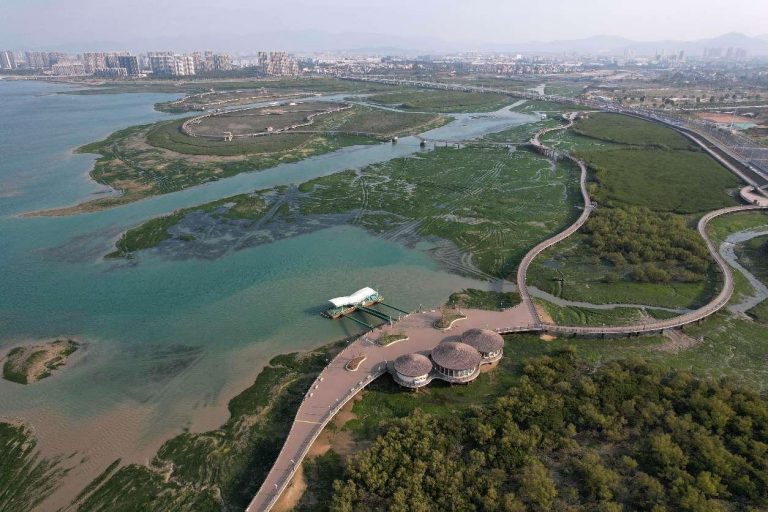
By Liu Yi, Chang Qin, Xiamen, the capital of southeast China’s Fujian province, is a typical bay city. It rises from the sea, drawn into its embrace.
The ecological conservation of bay cities is a global issue. These cities feature dense populations and industrial clusters, with significant pressure on resources and the environment. The challenges such as environmental pollution and biodiversity reduction often hinder their economic and social development.
How has Xiamen tackled these challenges and promoted harmony between humans and the sea?
In June 2002, Xi Jinping, then deputy Party chief and governor of Fujian, proposed the idea of shifting Xiamen’s urban planning from island-based to bay-based.
A development strategy was made to combine the development of Xiamen with the expansion of bays, combine urban transition with economic transition, combine rural industrialization with urbanization, and combine urban characteristics with the protection of bay ecology.
Xiamen has pioneered the concept of comprehensive bay-area governance in domestic coastal regions. It adopts a tailored approach for each bay.
Since 2002, the city has undertaken a succession of comprehensive renovation and development projects in five bay areas, namely Haicang Bay, Wuyuan Bay, Xinglin Bay, Tong’an Bay and Maluan Bay. By dredging seawall openings, restoring mangrove shorelines, and revitalizing beaches, Xiamen has created a pleasant living environment around the bays.
In the past, a large area of water in Maluan Bay was transformed into shrimp ponds and fish farms, leading to deteriorating water quality. To address the issue, Xiamen rolled out a comprehensive “combo” of initiatives, including returning reclaimed land to the sea, watershed management, and ecological water replenishment.
“The birds know the best about ecological conditions. Rare bird species like the oriental stork and black-faced spoonbill now flock to Maluan Bay to overwinter,” said Guo Qiang, director of the bird-watching association in Xiamen, while snapping photos of the birds.
Guo told People’s Daily that an ecological park has been built in the bay after dredging, and now it has become the top bird-watching spot for him.
Daitou Creek in Xiamen’s Tong’an district was once heavily polluted. The district implemented initiatives like full collection and treatment of sewage, clearing sediments from all waterways, and constructing wetland parks, to strengthen ecological protection and restoration.
The once black and stinky creek has now become a sound place for citizens, and its water quality was maintained at Class IV throughout last year.
Xiamen has carried out coordinated advancement in water resources, water environment, and water ecological management, to improve urban sewage collection and treatment capabilities, provide whole-area rural wastewater treatment, and prevent land-based pollutants from entering the sea. The proportion of wastewater discharge reaching standards into the sea has increased to 99.3 percent across the city.
The Xiatanwei Mangrove Park in Xiamen’s Xiang’an district presents a beautiful seaside scene with mangroves flourishing on the tidal flats, which sway gently when brushed by sea breeze.
Through a series of ecological restoration projects, the total mangrove area in Xiamen has increased from 32.6 hectares in 2000 to 173.9 hectares in 2023, with the ecological vitality and resilience along the coastline significantly enhanced.
Peter Thomson, the United Nations secretary-general’s special envoy for the ocean, has visited the Xiatanwei Mangrove Park twice. He highly commended the balance achieved by Xiamen between ecological protection and economic development, saying he looked forward to Xiamen providing a model for international marine ecological governance.
“Look! White dolphins!” On a boat ride to a rescue and breeding center for Chinese white dolphins in Xiamen’s Huoshaoyu Islet, people saw some Chinese white dolphins in the sea.
They joyfully swam in the water, occasionally leaping out of the sea. People couldn’t help but cheer excitedly, snapping photos and videos.
The Chinese white dolphin is guarded under first-class state protection in China. Since 2000, Xiamen has established a national nature reserve for 12 rare marine species, including the Chinese white dolphin and European lancelet, as well as their living environment, with an area of 7,588 hectares.
Chinese white dolphins like to inhabit and breed in bays at river estuaries, precisely where human activities are most frequent, posing huge protection difficulties.
Xiamen enacted China’s first local rules and regulations on Chinese white dolphin protection and built the first Chinese white dolphin rescue and breeding center. After years of efforts, the Chinese white dolphin population in Xiamen has gradually increased, from 60 in the early 1990s to over 80 now.
The Chinese white dolphin is an indicator of the marine environment, and Xiamen is one of the few cities in China where the Chinese white dolphin can be frequently observed from the urban area, said Wang Xianyan, a researcher with the Third Institute of Oceanography under the Ministry of Natural Resources.
“Over the past 36 years, Xiamen has invested a total of 105.6 billion yuan ($14.68 billion) in marine ecological conservation and restoration, achieving significant ecological, social, and economic benefits. This vividly demonstrates that blue seas and beautiful beaches are invaluable assets,” said Lu Lihua, an official of the Ministry of Natural Resources.










